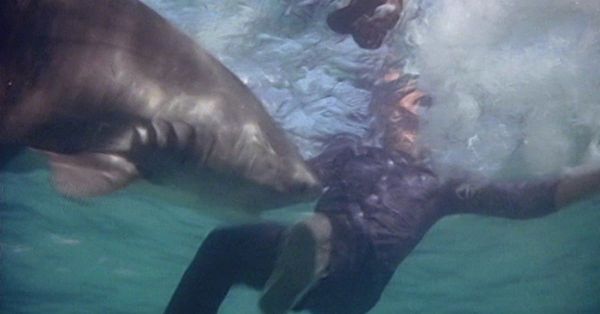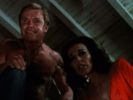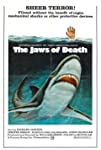Eye For Film >> Movies >> Mako: The Jaws Of Death (1976) Film Review
Mako: The Jaws Of Death
Reviewed by: Jennie Kermode

From the moment that Jaws first hit cinema screens, it was obvious that Steven Spielberg had succeeded in tapping into something special, and the race was on to bring more sharks to the screen. This was one of the first to make it over the line, and whilst it may look a bit rough and ready, it has substantially more plot and originality than most subsequent entries in the genre. It also stands out, and seems way ahead of its time, because it doesn’t present sharks as monsters who need to be killed, but as wild animals deserving of respect. It takes a chance on scientific theories which have since been substantiated, and aside from its ideas about shark family life and telepathy, it’s substantially more accurate than its more famous kin.
Yes, you read that right: telepathy. It wouldn’t be entirely off the mark to describe sharks as communicating telepathically with one another, given that they can send and interpret electrical impulses, but what’s going on here is a little different. Hero Sonny Stein (Richard Jaeckel) acquired a mystical telepathic connection with sharks when he needed their help to escape from attackers in the Philippines, attracting the aid of a shaman who gave him a special amulet dedicated to the local shark god. Whilst it doesn’t quite live up to the origin story in The Adventures Of Sharkboy And Lavagirl, this backstory is quickly delivered and, as the only fantastic element in the story, doesn’t derail it too much. The real focus is on Sonny’s desire to protect sharks, for which he’s quite willing to kill humans. Unfortunately, he can’t always tell which ones are a threat.

Enter Karen (Jennifer Bishop), who wears a spangly silver bikini and swims in a tank in her husband’s bar to attract customers. When she’s assaulted by two of them on the way home, Sonny steps in to help, but makes a mistake by letting her in on his secret. Her commitment is to show business, not to nature. Meanwhile, the local aquarium is engaged in some dodgy side dealing, handing over semi-tamed sharks as easy prey for hunters. As far as Sonny is concerned, this is murder, and those sharks are his friends.
Although there’s some really bad dialogue here and the acting is of dubious quality, parts of the film are quite stylishly shot, in keeping with the popular TV series of the time. The shark scenes may not be as dramatic or explicit as those in Jaws, but they feature far more real shark action. There’s a thank you notice in the opening credits, praising crew members who took real risks to capture it. These sharks may be smaller but they can still do serious damage, and they have a tendency to swarm. A serious effort has been made to try to edit the resulting footage in such a way as to show not only attacks but also social behaviours. This is a bit hit and miss, and won’t work as well for modern audiences as it did at the time of release, simply because we see a lot more of sharks these days, but it still has a degree of charm.
Keeping a fairly good balance between shark and human-focused storylines, the film – which got a retrospective screening as part of Fantastic Fest 2022 - holds viewer attention surprisingly well. Although much of it now comes across as comedic when it was clearly not intended that way, Jaeckel’s earnest performance, unusual in a leading man of that era, makes Sonny sympathetic throughout. You shouldn’t expect the same kind of thrills, dread and gore which the most successful shark films deliver to this day, but this is nonetheless a film which fans of the subgenre won’t want to miss.
Reviewed on: 23 Sep 2022

















